2020 EAAFP Small Grant Fund Project by
Phallis Eang
General Directorate of Natural Protected Area,
Ministry of Environment, Cambodia
Cambodia is located along the EAAFP and has become Partner of the East Asian-Australasian Flyway Partnership (EAAFP) since 2007. Cambodia wetlands provide essential habitats or the stopover site for many migratory birds including Great Knot, Nordmann’s greenshank, Asian Dowitcher, Black-tailed Godwit, Eurasian Curlew, Sandplover spp., Chinese Egret, Bar-tailed Godwit, Yellow-breasted Bunting, etc. as well as short distance migratory bird like Sarus Crane. To date, there are five wetlands which had been designated as Ramsar Sites and one designated as EAAFP Flyway Network Site.
Cambodia is rich in biodiversity and more than 600 bird species were recorded including land and waterbirds. However, there is little known about migratory bird hunting and trading. The relevant legislations related to illegal hunting are in place, but the dissemination on the illegal hunting of migratory waterbirds is limited.
Under EAAFP small grant project, an online workshop on bird identification and relevant regulation on illegal trading of wild birds were organized by the General Directorate of Administration for Nature Conservation and Protection, Ministry of Environment Cambodia in order to provide the capacity building to relevant authorities as well as raising the awareness to public. The overall objective of the workshop is to provide capacity building to site managers and rangers on the bird identification and relevant regulation on illegal trading of wild birds as well as share that knowledge to relevant people in their working stations.
The workshop was precise over by H.E. Kim Nong, Director General of General Directorate of Natural Protected Area, with 90 participations from 7 departments under General Directorate of Natural Protected Area, Department of Environmental Knowledge, Department of Community Livelihood, Department of Biodiversity, Department of Environmental Information and Dissemination, Department of Ecotourism, 12 Provincial Department of Environment such as Takeo Province, Kampot Province, Kep Province, Koh Kong Province, Battambang Province, Kampong Thom Province, Siem Reap Province, Stueng Treng Province, Kampong Cham Province, Tboung Khmom Province, Banteay Meanchey Province and Prey Veng Province, relevant NGOs including BirdLife International, NataureLife Cambodia, WWT, WCS, WWF, WA, WEA, as well as acadmics from the Pannasastra University of Cambodia and the Royal University of Agriculture.
Three training presentations were delivered by the trainers. The first presentation was delivered by Mr. Hong Chamnan on the basic of waterbirds identification. The next presentation was provided by Dr. Ding Li Yong from BirdLife International Asia and his presentation focused on the results of illegal bird hunting situation in Southeast Asia. The last presenter was Mr. Sou Sontara who present on the relevant laws and regulations related to illegal bird hunting in Protected Areas.
A number of awareness-raising materials focused on illegal trading and hunting of migratory birds were produced. Those included the video and posters which were developed and designed by youths. The posters were provided to relevant institutions especially to the Provincial Department of Environment and wetland site managers for awareness-raising purposes while the video was public in the social media platform reaching more than thousand public.
Through the training workshop, relevant departments, provincial department of environments, wetland site managers, rangers, academics and other participants who attended this workshop gained knowledge and understanding of the waterbird identification and relevant regulation on illegal trading of wild birds. They would share the knowledge with their colleagues and relevant people who work in the same field. Moreover, through the dissemination of posters and awareness videos, the public awareness of the disadvantages of illegal trading and hunting of migratory birds and also the negative impact of wild bird consumption on their health. The results from this project will contribute to the effort of reducing illegal trading and hunting of migratory birds. In addition, the trainees who are working on the ground will continue to share the knowledge and information from the workshop with their community.
It is recommended to conduct more training and dissemination workshops on law and regulation related to illegal hunting, trading and consumption of wild birds and involved more relevant people especially the site manager and rangers who work on the ground. It is one of the effective mechanisms to sustainably protect and conserve the migratory waterbirds for illegal hunting and trading. It is also recommended to organize a series of education and awareness-raising activities or campaigns at the ground level and to the local communities. In addition, more research studies on the hunting and trading of migratory waterbird species should be conducted to provide data and information for supporting the decision-making and policy development.
Web link: https://www.moe.gov.kh/index/32753
Facebook Post: https://www.facebook.com/314699302002531/posts/2096349793837464/
Video: https://fb.watch/j5qQMKaG1v/
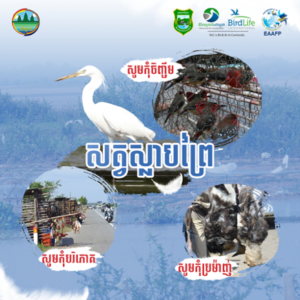 |
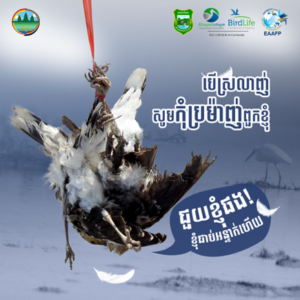 |
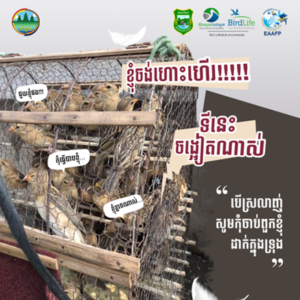 |
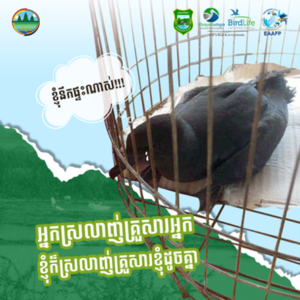 |
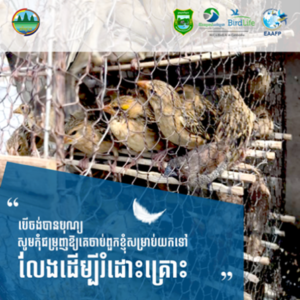 |
Awareness-raising posters were designed and disseminated to local stakeholders © Ministry of Environment, Cambodia
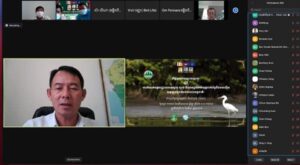
H.E. Kim Nong, Director General of General Directorate of Natural Protected Area, provided opening speech during the workshop on bird identification and relevant regulation on illegal trading of wild birds © Ministry of Environment, Cambodia
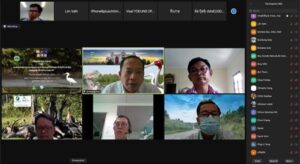
Trainers and Guest speakers delivered the presentation lecture to participants during the training workshop © Ministry of Environment, Cambodia
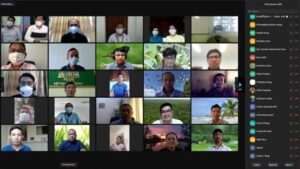
Participants to the online workshop on bird identification and relevant regulation on illegal trading of wild birds © Ministry of Environment, Cambodia
The project was funded through the 2020 EAAFP WG/TF Small Grant Fund. View the report, Click here.





